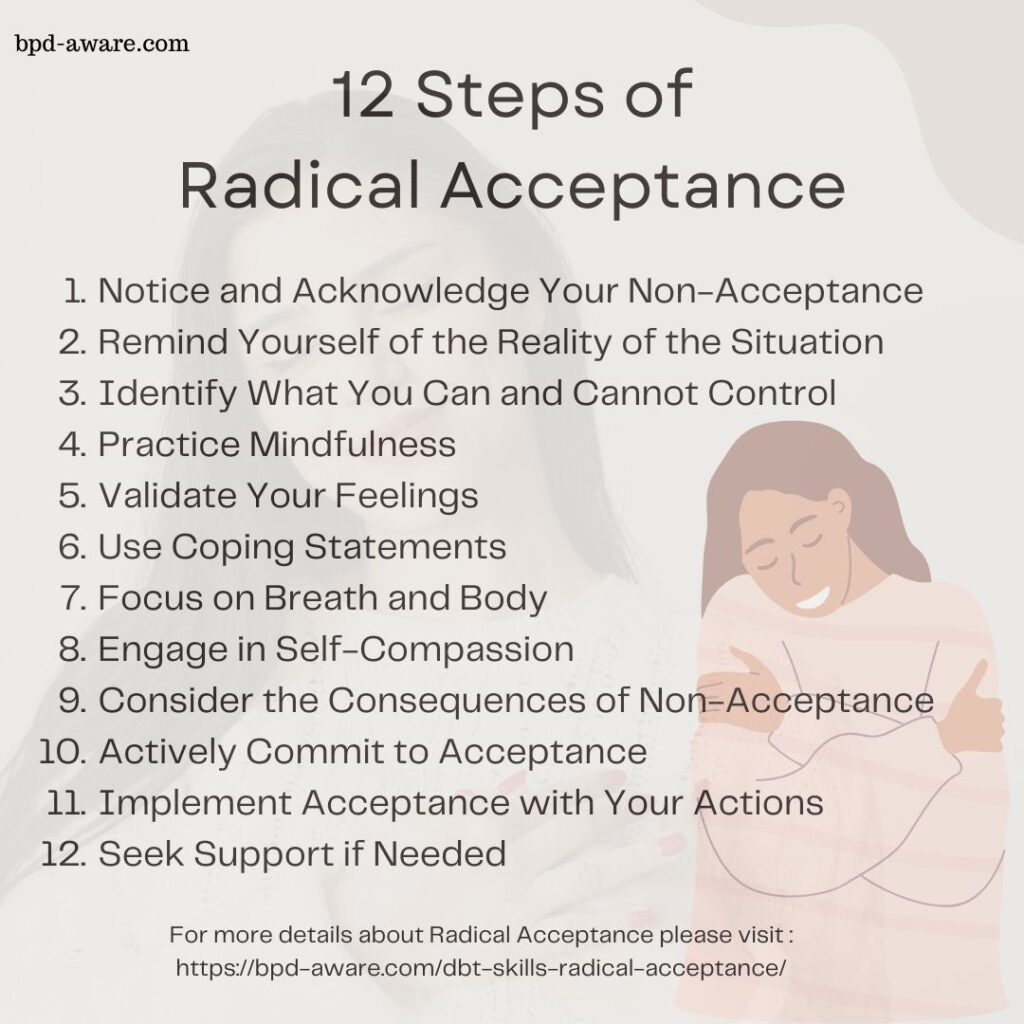One of the critical challenges people with Borderline Personality Disorder (BPD) face is issues with distress tolerance, which is the capacity to withstand emotional discomfort and stressful situations without resorting to maladaptive coping mechanisms.
Distress tolerance is a crucial component of emotional regulation, an area where many with BPD struggle. People with BPD often experience intense episodes of anger, depression, and anxiety that are more severe and longer-lasting than the typical emotional reactions of someone without BPD. Their lower distress tolerance means they may find it particularly challenging to cope with these intense emotions in healthy and productive ways.
This difficulty in managing negative emotions leads to impulsive actions and harmful behaviors, such as self-harm, substance abuse, or binge eating, as attempts to escape or diminish the distress. Moreover, these coping mechanisms can exacerbate the situation, creating a cycle of emotional pain and maladaptive behaviors.
The issues with distress tolerance in BPD can significantly impact the quality of life, affecting relationships, employment, and overall well-being. Relationships can be particularly strained, as loved ones and individuals with BPD navigate the unpredictable emotional landscape and the behaviors that stem from low distress tolerance.
What is Radical Acceptance?
Radical Acceptance is a vital skill within Dialectical Behavior Therapy (DBT), a form of therapy developed by Dr. Marsha Linehan, primarily for treating Borderline Personality Disorder but also effective for a range of other mental health conditions. This skill is foundational in DBT’s Emotion Regulation module and plays a critical role in helping individuals cope with distressing situations and emotions more effectively.
Radical Acceptance involves fully accepting reality as it is in the moment, without trying to change it, fight it, or deny its existence. It’s about acknowledging the facts of a situation, along with its associated emotions and thoughts, without judgment or resistance. The term “radical” signifies complete and total acceptance, extending to aspects of our lives and experiences that are painful, difficult, or beyond our control.

The Purpose and Benefits
The main aim of Radical Acceptance is to reduce suffering. While pain in life is inevitable, suffering often arises from our resistance to what is happening, leading to additional emotional turmoil. By practicing Radical Acceptance, individuals learn to distinguish between situations they can change and those they cannot, focusing their energy more productively.
Benefits of Radical Acceptance include:
- Reduced emotional distress: Accepting reality helps reduce the secondary emotional responses (like anger or frustration) that arise from resistance.
- Increased resilience: It fosters a greater capacity to cope with struggles and recover from adversity.
- Improved mental clarity: Acceptance can lead to clearer thinking, as it reduces the mental fog created by denial or wishful thinking.
- Enhanced emotional stability: It helps in stabilizing mood swings by minimizing the escalation of negative emotions.
Step 1: Notice and Acknowledge Your Non-Acceptance
- Begin by recognizing when you are fighting against reality. Signs of non-acceptance include feelings of anger, bitterness, or denial about a situation.
- Example: You might notice feelings of anger or resentment towards a friend who canceled plans last minute. Acknowledge these feelings as a sign of non-acceptance of the situation.
Step 2: Remind Yourself of the Reality of the Situation
- Clearly state what you are having difficulty accepting. It might be a specific event, a change in a relationship, a loss, or any other reality.
- Example: Recognize the fact that the plans have been canceled and cannot be reinstated at this moment. The reality is that you are now faced with unexpected free time.
Step 3: Identify What You Can and Cannot Control
- Distinguish between aspects of the situation within your control and those outside of it. Acceptance is often needed for the latter.
- Example: You cannot control your friend’s actions or the cancellation, but you can control how you respond and what you choose to do with your time now.
Step 4: Practice Mindfulness
- Engage in mindfulness exercises to ground yourself in the present moment. Observe your thoughts and feelings without judging them, merely acknowledge them as they are.
- Example: Sit quietly and focus on your breath, observe your thoughts and feelings about the cancellations as they arise, without trying to change or judge them.
Step 5: Validate Your Feelings
- Acknowledge that your feelings about the situation are valid, even if the situation itself cannot be changed. Validation is an essential step towards acceptance.
- Example: Tell yourself, “It’s understandable to feel upset about this cancellation. It’s okay to feel this way.”
Step 6: Use Coping Statements
- Employ coping statements to facilitate acceptance.
- Example: Repeat to yourself, “This situation is out of my control. Accepting it can help me find peace.”
Step 7: Focus on Breath and Body
- When resistance arises, focus on your breath and bodily sensations. Deep, mindful breathing can help calm the body and mind, making acceptance easier.
- Example: When you feel overwhelmed by emotions, take a few deep breaths, and focus on the feeling of air filling your lungs and your body relaxing with each exhale.
Step 8: Engage in Self-Compassion
- Be kind to yourself throughout the process. Practicing self-compassion can ease the pain of acceptance and foster a gentle approach to your experiences.
- Example: Treat yourself as you would a friend in the same situation. You might say to yourself, “This is a tough moment, and it’s okay to feel upset. I deserve kindness and understanding.”
Step 9: Consider the Consequences of Non-Acceptance
- Reflect on how non-acceptance has affected your life. Consider the emotional and physical consequences of resisting reality.
- Example: Reflect on how holding onto anger might ruin your mood for the rest of the day or strain your relationship with your friend, leading to further unhappiness.
Step 10: Actively Commit to Acceptance
- Make a deliberate choice to accept the reality of the situation. This might involve saying it out loud, writing it down, or engaging in an acceptance ritual.
- Example: Make a conscious decision to accept the situation by saying, “I accept that the plans have changed, and I cannot do anything about the cancellation itself.”
Step 11: Implement Acceptance with Your Actions
- Align your actions with acceptance. This means making choices that reflect your acceptance of reality, even if it’s challenging.
- Example: Decide to use the unexpected free time positively, such as reading a book you’ve been interested in or taking a relaxing bath.
Step 12: Seek Support if Needed
- If you find practicing Radical Acceptance too challenging on your own, consider seeking support from a therapist, a support group, or loved ones who understand the concept.
- Example: If you find it difficult to let go of your feelings about the cancellation, you might talk to another friend about your feelings or seek advice from a therapist.
These steps, when practiced regularly, can help in cultivating a mindset of Radical Acceptance. It’s important to remember that acceptance is a skill that takes time to develop. Each step can be practiced individually or in sequence, depending on the situation and your level of distress. Over time, with patience and persistence, radical acceptance can become a more automatic response to the challenges of life, leading to decreased suffering and increased emotional well-being.

Challenges in Practice
Implementing Radical Acceptance is a process that involves continuous practice and commitment. It’s important to remember that acceptance does not mean agreement, approval, or passivity. Instead, it’s about recognizing and coming to terms with reality to reduce suffering and make more effective choices moving forward.
Radical Acceptance is challenging, especially in the face of difficult or painful realities. It may require ongoing effort, support from a therapist or support group, and the use of various DBT skills. Over time, practicing Radical Acceptance can lead to greater emotional resilience, peace, and a more adaptive approach to life’s challenges.
Radical Acceptance is not about passivity or endorsement of harmful situations or behaviors. It’s also not a one-time decision but a continuous practice that can be challenging, especially in the face of significant adversity or trauma. It requires patience, practice, and often, the support of a therapist or a supportive community.
Final Thoughts
Learning the DBT skill of Radical Acceptance is a transformative journey that can significantly enhance one’s ability to navigate life’s inevitable challenges and reduce emotional suffering. This practice is not about passive resignation but about embracing reality as it is, with all its imperfections and uncertainties. By acknowledging and accepting the things we cannot change, we free ourselves from the bondage of futile resistance and open the door to new possibilities of healing, growth, and fulfillment.
The steps to Radical Acceptance, from recognizing non-acceptance and validating our feelings to making a conscious commitment to accept reality, offer a structured path toward cultivating this powerful skill. Each step, accompanied by practical examples, serves as a guide to gently steer us away from the turmoil of denial and resistance towards a place of peace and resilience.
It’s important to remember that mastering Radical Acceptance is a process that requires practice, patience, and compassion toward oneself. The journey might be challenging, especially when faced with deeply painful or complex realities, but the rewards are profound. Radical Acceptance teaches us not to struggle against what we cannot control, leading to a more serene and balanced life.
As we incorporate Radical Acceptance into our lives, we improve our well-being and also enhance our interactions with others, fostering deeper understanding and connection. In essence, radical acceptance teaches us to embrace life in all its complexity, finding beauty and strength in the face of adversity, and ultimately, paving the way for a more mindful, compassionate existence.
Sources, Resources, and Further Reading
- Radical Acceptance in a Time of Uncertainty: https://hopeway.org/blog/radical-acceptance
- Radical Acceptance: Skills, Worksheets, Videos, Exercises: https://dialecticalbehaviortherapy.com/distress-tolerance/radical-acceptance/
















